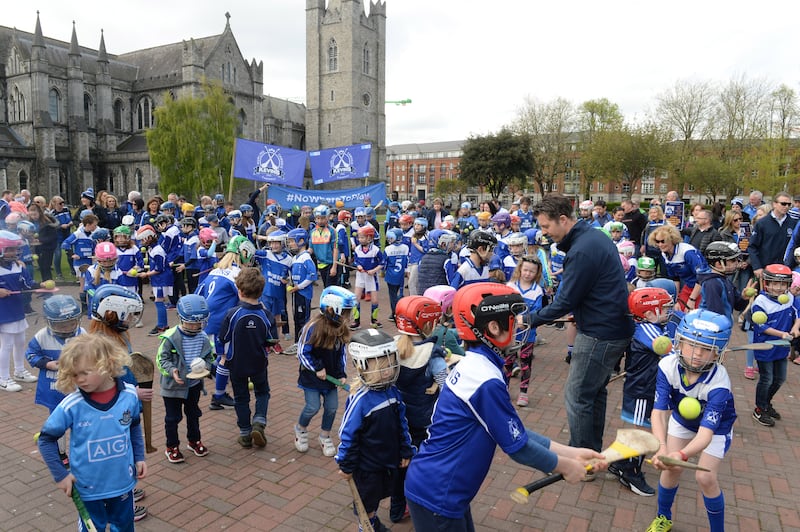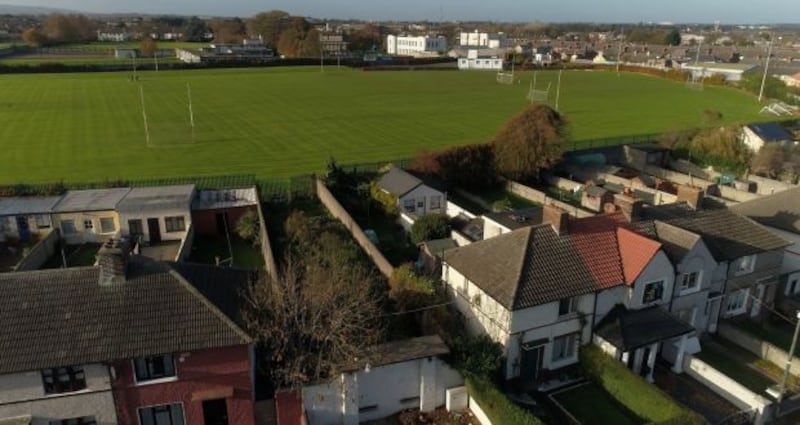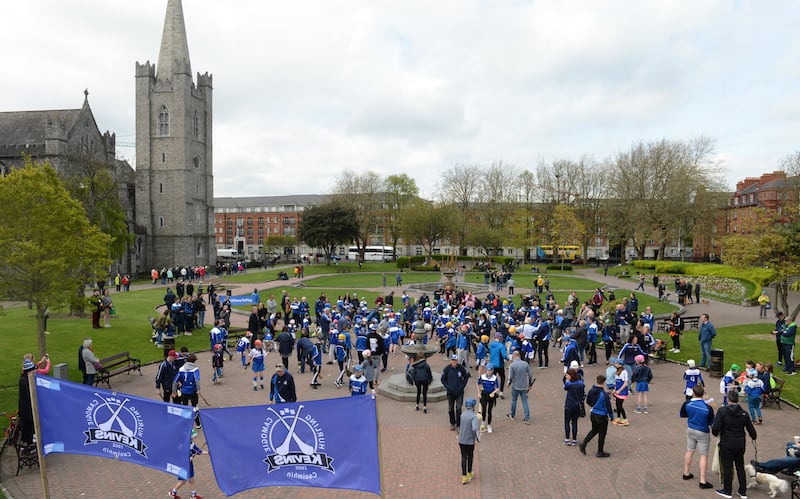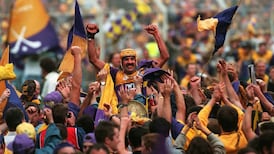Paul McManus coaches hurling for beginners in Dublin’s south-west inner city. On his rounds he visits 15 schools, none of which has a green space, or a yard where you could swing a hurley as nature intended and just let fly. Still, he puts a hurley in their hands and hopes they will grasp it.
In the biggest school on his rota the coaching sessions jink around flower pots and poles in a yard smaller than a badminton court. From that source 75 kids landed in the Kevins club nursery this year. You can only ask with an open mind.
It is 20 years since McManus started as the games promotion officer for the club. Kevins had been around since 1902, the only GAA club between the Liffey and the Grand Canal, a teeming borough of high-rise flats and terraced streets and escalating crime figures and dead-eyed concrete. That is his canvas.
“When I got involved I was saying, ‘Why would you get involved with this club,’” says McManus. “But when you come in it’s very hard to get out. Like, there’s nothing facilities-wise. This [club room] wasn’t even here when I started.
RM Block
“But there’s something about it. You’re kind of nearly sucked in. It’s a tough part of the city, but there’s something spiritual about it. We don’t lose many people. People don’t leave. That’s the thing about Kevins, there’s great people in it.”

Between hurling and camogie and rounders Kevins boast more than 30 teams now and more than 1,000 members. Their hinterland stretches through eight parishes, from Meath Street in the Liberties to Dolphin’s Barn on the rim of the canal, none of which was ever characterised as a GAA heartland. And yet, the club continues to grow and thrive and reach out and serve.
On the surface, there is nothing in their environment to support their existence. They have no pitch to call their own. Between the Liffey and the Grand Canal there is no green space big enough to stage a sanctioned match in any field sport.
According to the 2022 census, the 15 electoral divisions of Dublin 8, in the south-west inner city, have a population in excess of 47,000; the population within a 1km radius of Kevins club rooms on Donore Avenue, however, reaches well over 50,000. Young people, under the age of 19, make up about 8,000 of that number.
No playing pitch. For anybody. Think of where you live. Now think of that.
Research carried out by Gerald Mills, associate professor of geography in UCD, showed that of the 93 GAA clubs in Dublin, Kevins had by far the lowest ratio of green area per person, miles behind the club ranked 92nd on the list. In Dublin 8, the totting up of green space includes the grassy verges beside the Luas line and the canal. According to the same research, Kevins have made their home in the most “urbanised” and “paved” district of any GAA club in Dublin.
None of this is a sudden revelation. In Greening the Liberties, a document produced by Dublin City Council, it was illustrated that the area was “86 per cent below the internationally recommended level of green space per person,” for such a densely populated neighbourhood.
Kevins and their allies were alerted to the Aarhus Convention, a human rights document, to which Ireland is a signatory. Enshrined in the convention is “every person’s right to live in an environment adequate to his or her health and well-being.” The absence of green space in Dublin 8 is a clear breach of that convention. Does anybody care?
For years, Kevins and Sporting Liberties – an umbrella organisation that includes GAA, soccer, rugby and boxing – have been bombarding Dublin City Council and local politicians with their pleas for a space where sport can be played. They have aired their case on national television and in public meetings and in protest marches. They have met Government ministers and their plight has been raised on the floor of the Dáil. At every turn they have been met with soothing noises and expressions of support and deflection and delay and broken promises and inaction and paralysis in the system.
This calamitous failure of city planning is not a modern phenomenon, it has roots stretching back decades. JJ O’Mahony from Sporting Liberties has been one of the leaders of the campaign for more than 10 years, but he has a letter that Tom Hyland wrote to Dublin City Council, when he was chair of Kevins, pleading for a pitch, more than 30 years ago. The planning failures of the past were never corrected, only compounded.
Still no pitch.
Behind the data are human stories. Tom Magee is the President of Liberty Saints Rugby Club and one of the prime movers of Sporting Liberties. He wasn’t born in Dublin 8 but he met his wife here and spent eight years living in Dolphin House flats, near the canal. “My address isn’t here now,” he says, “but I’m constantly here.”
The rugby club was started from scratch 15 years by the late Graham Jones, and like Kevins, they brought their welcome to the schools. Magee remembers the first intake.
“We were involved with them over a five year period,” says Magee. “Two of them are dead now, three or four of them are into serious criminality, two or three of them have been involved with crime to the extent that their lives are f**ked. That’s just a small snapshot of 50 kids.
“Graham Jones had what he called a pastoral care model, where there would be 20 lads and four coaches – and those four coaches would link in with their five lads and their parents and their teachers all the way through their teenage years. Just to be someone they could go to if things went wrong.
“Those connections are still in place. I still get calls off the lads I was looking after. This is what goes on in a club. Connections are made. People look out for each other. That’s the bit that young people around here are being denied. Anyone that does get involved realises how shit the kids have it around here – and that if they walk away they’re abandoning those kids. And what are they abandoning them to? They’re abandoning them to crime, abandoning them to trouble.”

Jamie Treacy grew up in Dolphin House flats and has been playing hurling for Kevins since he was 10. He’s 27 now and runs his own business as an electrical contractor, with 14 people on his payroll. Of the team he started with in the club he’s the only one still playing. Many of the others, he says, went in “a wrong direction, lost to drugs or crime or prison.”
“Speaking for myself, I wouldn’t have had much hope I’d imagine without the club. You do eventually become the average of your surroundings. If you surround yourself with 20 criminals you’re going to become the 21st criminal. But when you start to communicate, and you start to mix with lads from the club, they start to show you a different direction in life - more than you would have been shown in Dolphin House.
“It’s not to say that by putting a pitch out in the middle of a congested, densely populated area it’s going to turn every child in that area into something special – and it’s not to say I’m something special, far from it. But I’m giving 14 other people [his employees] chances in life. A little bit of aspiration, if you like. Something else to be, more to the point.
“Listen, there’s plenty of communities within one larger community in this place, but there’s not many places where you can really feel comfortable. This [Kevins club] is one of the only places I’ve ever been where you can really be yourself and not worry about anything else.”

Crime figures for the first half of last year painted a disturbing picture. Assaults causing harm had increased by 87 per cent in the south inner city; robberies from the person had increased by 74 per cent; minor assaults had climbed by 96 per cent.
John Lonergan, who spent 22 years as the governor of Mountjoy Prison, has been involved with community groups in the south inner city since the 1980s. The imperative he and others saw was to treat the issues at source. They were trying to catch a wave in a bucket.
“There are many streets in this area,” he says, “where every family had a connection with Mountjoy. Even more depressing, many generations of the same family were there. That highlights the consequences of neglect. We erected these areas and failed to resource them. Many of the areas are no more than concrete jungles. Bleak, dead, depressing concrete, with no facilities. We respond when people are in trouble. We forget our responsibility to prevent trouble in the first place.”
Has it changed much since the 1980s? “It’s got worse,” he says. “It’s got worse.”
Those on the ground can see it. “Dublin City Council’s policies has herded these young kids into the hands of the drug lords and the criminals of this area,” says O’Mahony. “There are some that you will never change. But what we have found, and what people sitting up in Dublin City Council don’t see, is that these kids can be taken out of this environment and they can be positive contributors to society. More importantly than anything, you can actually save lives.”
“People that are coming out of their gaff at seven o’clock in the evening looking for something to do,” says Magee. “What are the lads doing? They’re buying and selling weed, or they’re selling bags of coke, or whatever. They’re not basketball players or rugby players or hurlers. That is the sport – it’s crime. If you’re going to get involved in a club, it’s that club. It is an underground club, but it caters for all their needs.”
About ten years ago a possibility dawned on Kevins and others. In the middle of Dublin 8 were three adjacent sites that had fallen into disuse, including the St Teresa’s Gardens flats complex. During the boom they were acquired by a developer whose plans never came to fruition and Nama was forced to intervene.
In 2013 the planning that had been granted on these sites lapsed and Dublin City Council invited submissions. Led by Kevins, and supported by detailed drawings, a proposal was made to ring-fence about one-fifth of the combined area of these properties and develop a pitch big enough for Gaelic Games and other sports.
The derelict St Teresa’s Gardens complex is opposite the Kevin’s club rooms on Donore Avenue and at one stage there were two pitches on that site big enough for soccer matches. Those pitches, though, were closed down by the council more than 15 years ago without any alternatives put in place.
Kevins and Sporting Liberties petitioned hard for a multi-purpose pitch on the footprint of the old soccer pitches. In a three page letter on June 28th, 2017, Dublin City Council proposed an interim solution, allowing for a 116m by 80m “municipal playing facility which will be sufficient to play full adult soccer matches, rugby and underage hurling.”
Six years later, that “interim” solution has still not been delivered. As things stand, the proposed pitch is stuck in the planning process, with no timeframe on an outcome.
More than €20 million was spent on the baths in Dun Laoghaire, and kids fecking dying inside here.
— JJ O'Mahony
On a parallel track, Sporting Liberties and Kevins turned their attention to a site on nearby Marrowbone Lane, owned by Dublin City Council, and currently being used as a depot. After a year of concerted lobbying the site was re-zoned for amenity use. They reached out to Jack Chambers, when he was Minister for Sport, and he indicated in conversations with them, and in answer to a Dáil question, that he was favourably disposed towards the development of a multi-purpose pitch at Marrowbone Lane.
He also made it clear that the next move was in the hands of Dublin City Council. Plans have been submitted. Their current status? In limbo. There is no timeframe an outcome.
“There must be 10 or 15 big flats complexes around Dublin 8,” says Magee. “Lots of people in addiction, lots of people on disability allowances in the area. And they treat this area like the drawer in your kitchen that everything gets f*cked into. They don’t give a shit about it.
“The people around here are just as entitled as the people of Stillorgan or Foxrock to have a pitch. They have every right, the same as everyone else around Ireland, to basic stuff. A pitch. It’s as basic as it gets. We’re not looking for a stadium here with floodlights or anything like that. Basic rights.”
“Dublin City Council wanted to do white-water rafting down in the IFSC,” says O’Mahony, “when there were kids dying in here. More than €20 million was spent on the baths in Dun Laoghaire, and kids fecking dying inside here.”

For more than 80 years Kevins have played their matches in Dolphin Park, the home of Templeogue Synge Street, a few hundred metres south of the Grand Canal. A few years ago, however, that relationship became complicated and inflamed. Templeogue Synge Street brought a planning application for 161 apartments on a portion of Dolphin Park, which Kevin’s believed would significantly reduce their access to the site.
[ GAA club gets green light for 161 homes in Dolphin’s BarnOpens in new window ]
The planning application was turned down by Dublin City Council, but was granted on appeal by An Bord Pleanála. In response, Kevins brought an action to the High Court and the planning application was quashed. In the heat of the conflict, Kevins’ adult teams were threatened with eviction from the grounds. In the end, nothing of the sort happened. Diplomacy prevailed. A good working relationship has been restored.
But when the episode erupted it made them vulnerable in a way they didn’t expect. Whatever rights they have, Dolphin Park doesn’t belong to them. More than that, it sits outside their catchment area. On the night that we met, McManus mentioned two Kevins kids’ teams that were training in different school halls that night, neither of which was inside the canal.
While we chatted, two camogie players arrived into the meeting room to drop off gear after a training session that had just finished somewhere else. On Saturday mornings, their nursery groups train in another school. Everything is scattered and dependent on others.
“A lot of this has been made worse by how big the club has become,” says Vincent Hennessy, the Kevins chair. At the current rate of growth, they worry about not being able to accommodate every kid that wants to play. Without a pitch, how much more capacity is in their gift?
“It reminds me of Putin’s Russia,” says O’Mahony. “You batter the people down for so long that they don’t have the stomach or the guts to rise up.”
They haven’t taken a backward step. The fight continues. The scandal continues.






















